8
Atomic, Molecular, and Optical Science: Part of the U.S. Economic and Societal Ecosystem
In the preceding chapters, the committee has highlighted the amazing achievements of atomic, molecular, and optical (AMO) science over the past decade, and shown the opportunities these present for future scientific discoveries and new technologies. Recognizing, however, that AMO science does not get done in isolation from the economic and societal structures in which the community operates, in this chapter, the committee examines the state of the field of AMO science in relation to these structures. In similar vein, AMO science is carried out in the global arena, with broad and interdisciplinary reach. We discuss funding, education, workforce development, broad demographic participation, and the global positioning of U.S. AMO science. We use trends over the past decade to take stock of how AMO science is doing with regard to these criteria, and present strategies for confronting challenges and taking advantage of the opportunities identified.
Several factors have contributed to the eminence the United States has enjoyed in AMO science over many decades. These include sustained government funding, extensive investments by academic institutions and industrial research centers, effective translation of AMO research to commercialization and products, and a vibrant, engaged community of scientists worldwide. But AMO science in the United States can also better avail of opportunities to grow its numbers by engaging a broader representation of the changing U.S. population, to maintain and expand funding sources and to ensure that international participation in the U.S. scientific enterprise remains open to citizens of all countries. These topics are explored in this chapter.
INVESTMENTS IN AMO RESEARCH: FUNDING, COLLABORATION, AND COORDINATION
Federal Funding
Spending on AMO-related research is an important measure of the opportunities in the field, and of U.S. competitiveness and leadership. In addition to support from academic institutions, industrial partnerships, and private foundations, AMO sciences enjoy substantial federal funding. In constructing the profile for how AMO science is funded in the United States, the committee reached out to the following agencies that have AMO science within their portfolio: the National Science Foundation (NSF), the Department of Energy (DOE), the National Aeronautics and Space Administration (NASA), the National Institute of Standards and Technology (NIST), and a number of arms of the Department of Defense (DoD)—the Defense Advanced Research Projects Agency (DARPA), the Air Force Office of Scientific Research (AFOSR), the Office of Naval Research (ONR), and the Army Research Office (ARO).
In order to understand the impact of federal funding on AMO research, the committee set out to answer the following questions pertaining to aggregate AMO spending across all programs, with the goal of determining if funding for AMO sciences has remained robust over the past decade:
- What was the absolute number of dollars spent on AMO research each year over the past decade at the queried agency?
- What was the distribution of grant size each year for the past 10 years?
Since the committee also attempted to understand opportunities for early career scientists to secure federal funding for their research, the agencies were also asked:
- Over the past decade, how many awards go to grantees each year as a function of the grantee’s time past Ph.D.?
The committee asked for this to be divided into three time bins: 5 years after Ph.D., 10 years after Ph.D., and beyond 10 years after Ph.D.
The committee received detailed responses from several, but not all, agencies, and in some cases, with caveats. These are shown in Table 8.1. The trends for funding in the aggregate, based on the data in Table 8.1, are shown in Figure 8.1. The total amount of dollars (in millions) spent on AMO-related research is plotted for each of the past 10 years, from 2008 to 2018. Each data point is the sum of spending reported by all the agencies that provided the data. This plot is based on the “sum” row of Table 8.1, where annual spending is broken down by agency.
TABLE 8.1 Funding Histories in AMO Science (20082018) (millions of dollars)
| Year | DoD | DOEc | NISTd | NSFe | DoD/DOE/NIST/NSF | |||||
|---|---|---|---|---|---|---|---|---|---|---|
| AFOSRa | ARO | DARPAb | ONR | AsSpent Total | Deflatorf | FY2018 $ | ||||
| 2008 | 4.00 | 8.55 | 9.6 | 1.55 | 14.70 | 76.86 | 22.15 | 137.41 | 0.854 | 160.86 |
| 2009 | 4.00 | 11.29 | 17.68 | 3.9 | 20.10 | 79.78 | 22.25 | 159.01 | 0.861 | 184.75 |
| 2010 | 4.00 | 7.03 | 11.44 | 2.2 | 20.10 | 79.46 | 23.55 | 147.78 | 0.871 | 169.73 |
| 2011 | 4.00 | 9.29 | 57.58 | 2.12 | 21.60 | 80.74 | 23.07 | 198.39 | 0.889 | 223.2 |
| 2012 | 10.00 | 8.51 | 29.2 | 2.19 | 20.10 | 83.32 | 23.02 | 176.33 | 0.906 | 194.64 |
| 2013 | 10.00 | 9.74 | 33.92 | 2.73 | 20.10 | 85.07 | 21.01 | 182.56 | 0.922 | 198.05 |
| 2014 | 10.00 | 13.04 | 11.65 | 3.96 | 21.00 | 86.34 | 21.08 | 167.08 | 0.939 | 177.89 |
| 2015 | 10.00 | 12.05 | 8.32 | 3.08 | 20.40 | 87.73 | 22.19 | 163.76 | 0.949 | 172.51 |
| 2016 | 10.00 | 9.62 | 23.4 | 2.75 | 21.60 | 87.81 | 22.17 | 177.35 | 0.960 | 184.8 |
| 2017 | 10.00 | 10.11 | 2.85 | 2.92 | 21.90 | 88.96 | 22.63 | 159.37 | 0.978 | 162.97 |
| 2018 | 10.00 | 11.05 | 7.27 | 3.45 | 23.40 | 90.82 | 22.54 | 168.54 | 1.000 | 168.54 |
a AFOSR mentioned the cost of only two major programs: the Atomic and Molecular Physics program at about $4 million per year, and the Ultrashort Pulse LaserMatter Interactions program, which started in 2012, at about $6 million per year. Funding for MURI programs, some of which is directed to AMO research, is not included by AFOSR nor ONR, although it is included by ARO.
b DARPA data for 2008 is a lower bound that was inferred from the Services, and not provided by DARPA. Note that DARPA programs do not represent generic (or core) funding for AMO, but are focused initiatives that come and go.
c DOE did not provide actual numbers; instead, these figures represent rough estimates from a bar graph that they did provide, reduced by a factor of 97 percent, as they instructed.
d NIST data extrapolated from AMO2010: $70 million in 2005 adjusted using year over year CPI inflation rates, as published by the Federal Reserve Bank of Minneapolis (see https://www.minneapolisfed.org/community/financialandeconomiceducation/cpicalculatorinformation/consumerpriceindexandinflationrates1913).
e Does not include Plasma or QIS programs.
f As calculated from rates published by the Federal Reserve Bank of St. Louis, https://fred.stlouisfed.org/release/tables?rid=53&eid=41158.
Figure 8.1 and Table 8.1 show that federal funding for AMO-related science over the past decade has more or less held steady, but with significant year-to-year fluctuations. The largest year-to-year variations in AMO spending occurred at DoD (primarily in DARPA and to a lesser extent at the Services). DARPA has a large budget with significant changes in how funds are directed from time to time. Prior to 2003, for example, relatively little AMO-related basic research was funded by DARPA. Periodic increases in AMO funding can be ascribed to program officers who identify specific opportunities or target particular areas, and direct funding accordingly. Furthermore, Figures 8.1b and 8.1c show that spending (and hence budgets) for AMO research by NSF and DOE have remained close to flat over the past decade, in 2018 constant-dollars, while NIST has increased almost steadily, and as mentioned DoD has had large year-to-year fluctuations.
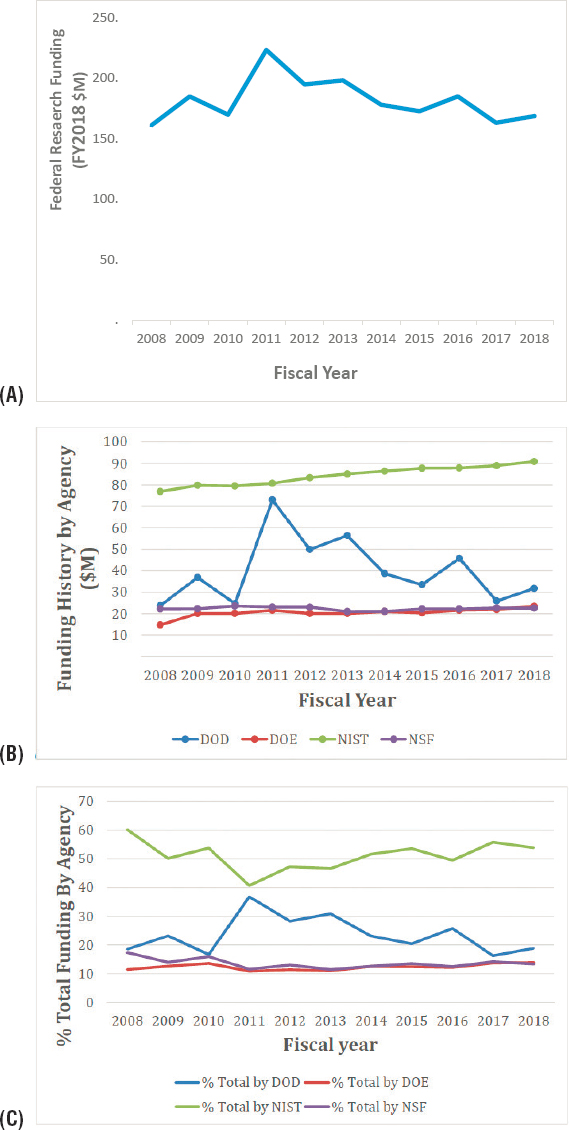
Traditionally, AMO physics has been carried out by small groups in table-top-scale experiments. While this is still at the core of AMO experiments, there are increasingly opportunities for AMO science to contribute to other areas of science in larger, multidisciplinary teams that require funding modalities that need to adapt to these needs. Examples of these are the Laser Interferometer Gravitational-Wave Observatory (LIGO) project, and on a smaller scale, experiments like ACME and Axion Resonant Interaction Detection Experiment (ARIADNE). These are elegant experiments that use the techniques of AMO to probe astrophysics and fundamental properties of known and yet undiscovered particles.
Efforts such as these highlight the need for interagency funding modalities with longer horizons. Strong interagency coordination to achieve optimal balance for funding between single investigators and collaborations with varying sizes would be very beneficial for availing of these opportunities and for facilitating the discovery potential of AMO. Flexibility in funding structures will be imperative, responding to both existing and rising opportunities in a timely fashion. Many of these bigger-than-table-top-scale experiments are in the domain of questions of fundamental interactions traditionally explored through DOE support. Another area DOE has become increasingly interested in is helping shape the future of quantum information science and technology. It will be important for DOE to work together with NSF, NIST, DoD, and even NASA to identify fundamental physics questions and applications that can be best addressed, both within the DOE National Laboratories and outside, with investment in quantum and AMO science. As another example, to build powerful quantum machines and use them to solve important scientific and technological problems will require teams working between large facilities to address material and technical challenges and smaller sized groups to tackle fundamental issues in quantum information science.
Another concern is the high threshold to entry for early career AMO scientists. As AMO laboratory programs grow more expensive to seed, it gets prohibitively expensive for smaller colleges and universities to hire AMO scientists as assistant professors. A likely contributor is the ballooning startup costs resulting from the cumulative costs of the many custom pieces of equipment that are required to put together increasingly complex and precise experiments. A possible solution may be a new funding model for such home-built pieces of equipment that do not fit into typical NSF Major Research Instrumentation Programs. Recognizing startup costs as a serious barrier that has a negative impact on the breadth and diversity of students with training in AMO laboratories, something that has been identified as a national need (see the section below, “Workforce, Educational, and Societal Needs”), the committee tried to determine how funding is distributed among early, mid-, and late-career researchers, but could not consistently access such data. The committee learned, for example, that CAREER awards—for outstanding scientists at the beginning of their academic
careers—made up 6 percent of all awards funded by the NSF AMO program, averaged over the past decade. According to current membership data collected by the American Physical Society (APS; see the section “Workforce, Educational, and Societal Needs”), 47 percent of scientists who identify with the Division of Atomic, Molecular, and Optical Physics (DAMOP) are students. While NSF CAREER grants are only awarded to the very best of new incoming faculty, and not all of those DAMOP students will even go into academic careers, the small fraction of these grants relative to the numbers of young people in the field may point to the need for directing more funding to early career investigators. Because we recognize that this is not a strong, data-driven correlation between a small subset of early career funding and early career membership to the DAMOP, this points to the need for a separate study to determine the optimal level of funding for starting faculty.
A possible modality for supporting early career AMO academicians could be prestigious postdoctoral fellowships that can be ported between institutions. Such fellowships could be awarded to postdoctoral scholars before they start faculty positions, and could be used to defray startup costs that many smaller institutions cannot incur.
Interagency and Industrial Connections of AMO Science
AMO research is a worldwide activity, with significant investments in AMO science in Europe, Asia, and Australasia. AMO science is also a multidisciplinary enterprise; strong connections to other areas and to industry are highlighted in Chapters 6 and 7. Consequently, it is important to support and amplify this interconnectivity both through international collaborations and in the context of multiple U.S. federal funding agencies, state-level funding opportunities, industry, and education and outreach to engage the public that supports scientific research.
Within the United States, AMO research is largely funded by several federal agencies and is a significant component of many industries. AMO-trained scientists populate virtually every type of commercial undertaking, from manufacturing to financial services. This has grown to the point that there is now significant “back-action”: it is important for the AMO community to learn from industry on their pressing needs for workforce and how best to train students to meet these needs. Close working partnerships between AMO and industry will be critical for technology transfer and development of innovative products. It can also strengthen support for fundamental science. Strengthening partnerships among the different federal funding agencies and between agencies and industry will further cement these connections and increase the immediate societal impact of AMO-based training and technologies.
Within agencies, there is support for interdisciplinary research activities. The NSF AMO program, for example, co-funds research with nearly a dozen other programs across NSF. Within and across DoD agencies there is also significant interdisciplinary and cross-program funding. However, across multiple different agencies there is a larger challenge. There are specific instances of programs where NSF, DoD, and DOE have (pairwise) co-funded programs, but this is more the exception than the rule. As highlighted in preceding chapters, there will be great benefit to all parties to make this easier or more natural to do when the situation arises.
Translation of AMO Research to Industry
In Chapter 7, we discussed the impact that AMO has had on society through both widely publicized discoveries and technology transfer to industry—through start-ups, research and development (R&D) collaborations, and intellectual property licensing through universities. A particularly vivid example is provided by the telecommunications industry, which had to dramatically reduce losses in optical fibers, improve the power and frequency stability of lasers and the sensitivity of photodetectors, and then field these technologies across the globe on cost-effective and reliable platforms. Higher levels of integration have generally enabled scaling to much higher volumes at still lower costs (i.e., “Moore’s law”), and integrated photonics based on III-V semiconductors rapidly grew into a USD $0.5 billion to $1.0 billion industry driven by demand for Internet connectivity. In parallel, the field of silicon photonics was launched in the 1980s and 1990s by academic researchers who were interested in harnessing submicron silicon-on-insulator optical structures to create first passive (waveguides, splitters, optical fiber couplers) and then active devices (modulators and detectors) for applications ranging from data transceivers to labs-on-a-chip. The data communications industry—responsible for fielding interconnect networks for data centers and high-performance computers—followed this research closely, and by the turn of the century startups began to appear with the intention of commercializing this research.
This new era of high-commercial-volume, high-reliability, low-cost datacom photonic circuits—now a USD $1 billion industry that is likely to grow much faster than telecom—brings a tension between the different approaches used by academia and industry.
- As photonics has evolved to ever larger scales of implementation and adoption, reliability of the underlying components has continued to increase in importance. In academic papers and conferences, the very best results are emphasized. But in industry, public dissemination of product capabilities generally makes a more conservative pitch. Industry has learned how to
- build in reliability at the substrate level, and this information is widely available to the academic community.
- The software and hardware tool chains that are used by industry to design large-scale photonic circuits are adapted from those used by the CMOS industry and are quite powerful and sophisticated. Graduate schools in electrical engineering have been teaching their students to use these tools for more than 20 years, but very few AMO physics departments have begun to follow suit.
- Similarly, converting a scientific experiment into a technology involves a deep awareness of design, integration, packaging, and reliability. These skills have traditionally not been taught in AMO research laboratories, so industry must engage in a significant amount of on-the-job training to bring their new, young scientists up to speed. There are now a few academic centers of excellence with this sort of training in mind. For example, the Engineering and Physical Sciences Research Council is funding the University of Bristol’s Centre for Doctoral Training in Quantum Engineering, which is designed to educate graduate students in modern manufacturing and fabrication techniques to speed product development in this new field. In the United States, NSF has launched the Research Traineeship Program with the intention of performing a similar function.
Bridging this gap between current practices and the goal of educating students in the methods and tools of importance to industry is well within the capabilities of the nation’s universities.
AMO Science Internationally
There is good evidence that the U.S. investments in R&D are declining relative to other parts of the world (see, e.g., Figure 8.2), even as the United States contributes 19 percent to the overall increase in worldwide expenditures on R&D (NSB Science and Engineering Indicators 2018). While these were not AMO-specific, we can expect that AMO science follows similar trends. Attempts at collecting country-specific data on international funding of AMO sciences proved to be futile. But anecdotally, we see that worldwide investments in AMO science are growing at a faster pace than in the United States. The committee examined AMO opportunities in other parts of the world in order to identify possible strategies that could be used in the United States. Of particular note were the extensive investments in AMO sciences and technologies in Europe through Framework Programmes for Research and Technological Development and the Quantum Flagship, a large-scale research and innovation initiative. In addition to national programs in European Union (EU) member nations, Europe also has network funding mechanisms
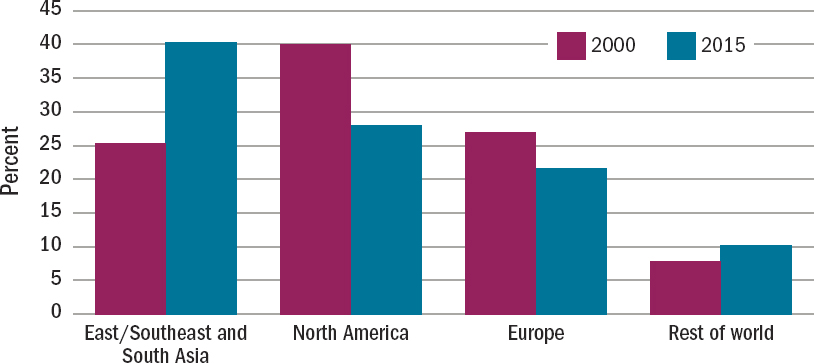
through which multiple funding organizations from multiple countries coordinate research in quantum information sciences. These methods of support could serve as models for the United States as the need for greater interagency funding grows. One avenue we see for remaining competitive and using the available resources most effectively would require collaborations between U.S. agencies not just among one another but also internationally.
The committee used publication in peer-reviewed journals as one measure of the volume of AMO research performed in various countries. We are aware that the quality of publications can vary, but total number of publications should be a reasonable measure of engagement in AMO research. In absolute number of publications, China and the United States led all other countries, as shown in Figure 8.3a. However, when the total number of publications are scaled by population for each country, the authorship per capita placed Germany in the lead, as shown in Figure 8.3b. A similar analysis of authorship per gross domestic product (GDP) is shown in Figure 8.3c.
Using these publication trends over the past decade as a proxy for research volume, we see that there has been sharp growth in the number of publications originating from researchers at Chinese institutions compared to all other leading countries. With the exception of China and to a lesser extent the Russian Federation, research publications per capita or per GDP show a declining trend over the past decade. It is also worth noting that several members of the EU—Germany, France, Italy, and the United Kingdom—are among the top 10 countries with
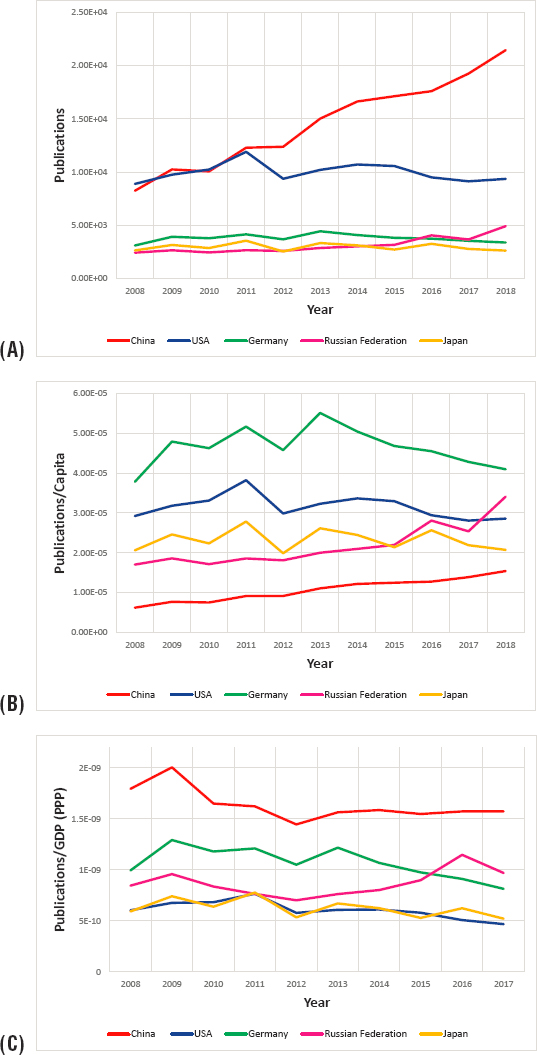
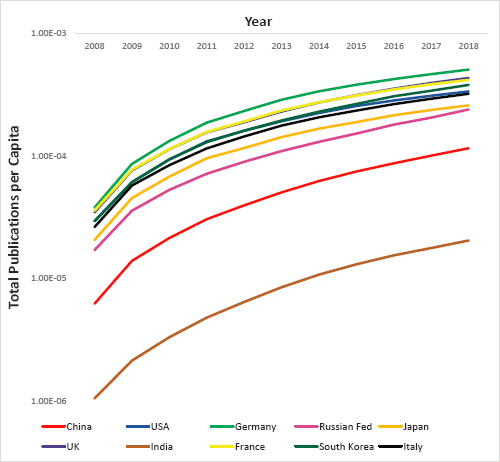
the largest number of publications per capita in AMO-related sciences, as shown in Figure 8.4.
WORKFORCE, EDUCATIONAL, AND SOCIETAL NEEDS
Education and Workforce Development
Looking to the future, the health and vibrancy of the AMO ecosystem depends on—and contributes to—the development of a technical workforce prepared for 21st century challenges. A significant measure of the workforce of the future is given by current trends in education and employment. To determine the educational trends in AMO science, the committee studied data from the American Institute for Physics (AIP).
Figure 8.5 shows the number of Ph.D. degrees conferred in physics by field of study for the years 2013 and 2014 combined. Of the 1,773 Ph.D.s granted at U.S. institutions of higher education, 99 Ph.D.s were in atomic and molecular physics (5.6 percent) and 79 Ph.D.s were in optics and photonics (4.5 percent). Atomic and molecular physics plus those in optics and photonics (AMOP) combined with 178 is tied at third place for the largest subfield of physics. While the number of physics Ph.D.s rose 68 percent from 2002 to 2015, AMOP Ph.D.s rose by only 52 percent. Figure 8.6 shows the number of Ph.D.s granted in physics at U.S. institutions, and also the sum of Ph.D.s in AMOP for the years 2002 through 2015.
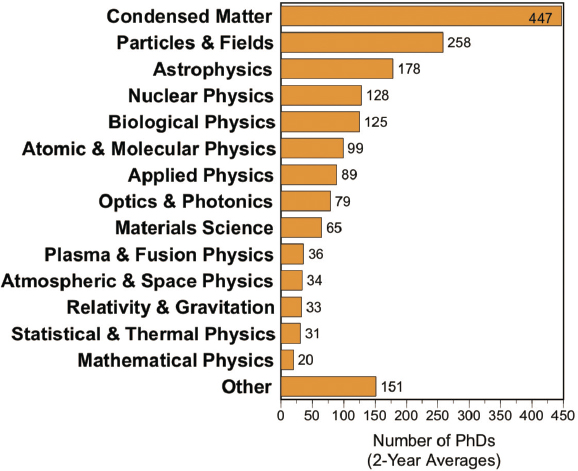
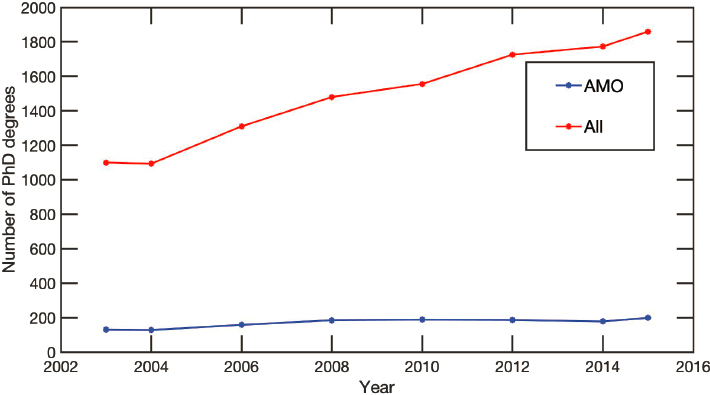
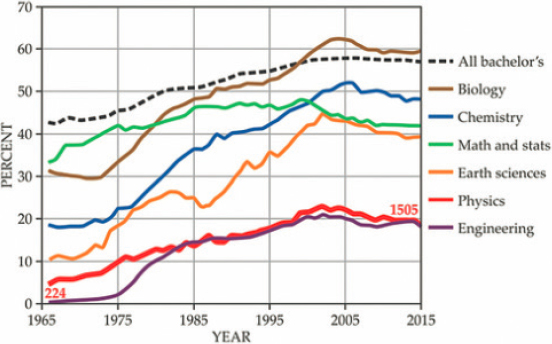
To evaluate whether there were missed opportunities to broaden participation in the workforce, the committee studied as an example education trends for women and underrepresented minority (URM) students. We delve into this topic a bit more in the following section on demographics. Figure 8.7 shows the trends for the percentage of women earning science, technology, engineering, and mathematics (STEM) degrees in the United States. The committee notes that women now earn nearly 60 percent of all bachelor’s degrees in the United States (see NCES 2019-038), but comprise just about 20 percent of physics majors in bachelor’s programs, a number that has remained static over the past decade (see AIP Report on Women in Physics and Astronomy, 2019).
Similar data were not available for URMs, but experience at our home institutions strongly suggests that the participation of those groups is even smaller. Bridge programs have increasingly shown promise to enhance URM participation in physics, from the longstanding examples like Fisk-Vanderbilt to the more recent APS Bridge programs. Particularly promising are when programs start earlier, while students are still in their undergraduate years, with Cal-Bridge showing very positive outcomes. We encourage others to follow these models, or collaborate with them.
Taken together, this presents a very significant opportunity—an imperative even—to increase the number of women and URM students training to be physicists. In order to achieve greater representation, a number of systemic barriers faced by women and URM students must be overcome. Some of the challenges women face as physicists, ranging from implicit bias to male-dominated subcultures, are
discussed in an excellent article by Blue, Traxler, and Cid that appeared in the March 2018 issue of Physics Today, (https://doi.org/10.1063/PT.3.3870).
A large component of AMO scientists in the United States comprises those not born in the United States. There is a longstanding tradition of talented AMO scientists coming to the United States from other countries—as students or thereafter—and building productive careers here. Some of the most outstanding American citizens practicing AMO science were born outside the United States. NSF’s “Science and Engineering Indicators” report shows that foreign-born scientists make up about half of the Ph.D. holders in “physical sciences,” but anecdotally it seems that intellectual immigrants contribute disproportionately to AMO science, even relative to this figure.
The need to attract and retain brilliant foreign-born scientists is critical to the continued health of AMO science, and the American scientific enterprise more generally. It is, therefore, imperative to preserve—and indeed improve—mechanisms by which non-U.S.-born scientists can contribute to U.S. scientific enterprise, and to ensure that the United States remains as welcoming a place to pursue AMO research as ever.
As part of our data-gathering efforts for this report, the committee also conducted two town hall meetings, held during the annual meetings of the APS and the Optical Society of America (OSA), respectively. The APS has more than 55,000 members, including physicists in academia, national laboratories, and industry in the United States and throughout the world. The Division of Atomic, Molecular, and Optical Physics (DAMOP) is a unit of the APS; its membership is represented in Figure 8.8. As noted below, other APS divisions are increasingly connected to DAMOP ideas, and conversely.
At a town hall meeting held at the 2018 DAMOP annual meeting, prominent members of the AMO community raised concerns, but also expressed enthusiasm for the achievements of AMO science over the past decade, and optimism for the future. Chief among the concerns raised were the funding trends that had not kept up with the growing AMO activities, shown in Figure 8.1, and the consequent danger of U.S. scientists losing their competitive edge. The very small number of theoretical AMO physicists in the United States was raised as a concern. Another was that as many AMO research group sizes have grown, and been supported by more project-driven funding sources, these might be supplanting curiosity-driven research, which is the mainstay of discovery. It was also noted that the short (3 years or fewer) funding cycle for most federal grants makes it very difficult to maintain and augment infrastructure in research groups. Despite these concerns, there was also wide recognition and celebration of the role AMO science has played—and is anticipated to continue to play—in some of the most important scientific and technical advances of the past decade. These include developing platforms and tools for quantum computing and quantum information science more broadly; novel
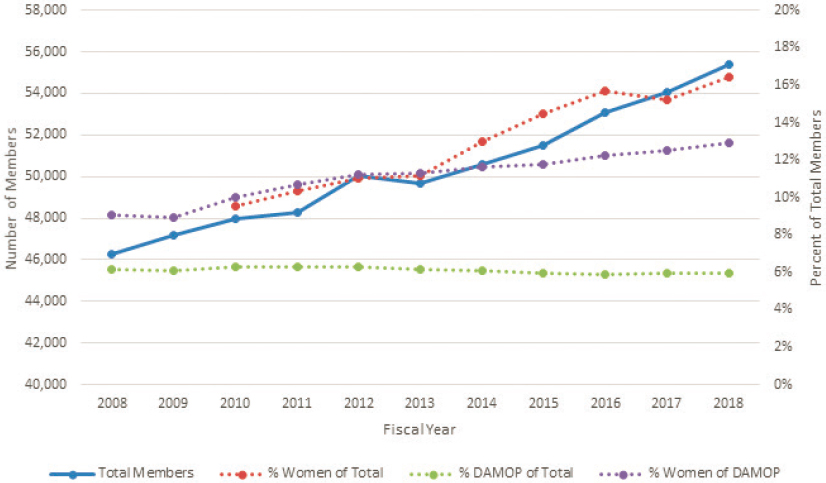
biomedical diagnostics; advancing the precision frontier with the development of clocks, further improvements in metrology, and the detection of gravitational waves; synthesizing new forms of matter; and observing light-matter interactions at unprecedented high intensities and speeds.
An important piece of feedback that the committee collected from industry on workforce training is the rising need for AMO-trained students, especially in the rapidly evolving fields of integrated photonics and quantum information science and technology. This growing need for technically trained workers who have had AMO-related experience in laboratories during their education is easily understood: industry needs most closely match AMO training. Thus, trained undergraduate and master’s degree students with sufficient knowledge in AMO are actively sought by industry, particularly those who have had a reasonable exposure to AMO laboratories. The laboratory experience is invaluable since no classroom or textbook can prepare a student for the laboratory, where the full complexity of apparatus manifests and interacts with the environment in uncontrolled ways. This national need illustrates the opportunity for the AMO community to improve
upon the current education curricula and provide innovative laboratory training for students.
The need for more resources to train AMO students extends beyond the need for bachelor’s (or higher) degree holders. An underestimated, but important, sector of a technical workforce is the skilled technician. Skilled technicians with “golden hands” in the laboratory—essential resources for scientists in industry, academia, national laboratories, and government—can often be extremely productive with less than a full formal education. The skill sets of qualified technicians readily translate from academia to industry, and just as easily from industry to academia.
Many talented technicians have completed a few relevant community college courses, polytechnic training, or in some cases training for military technical certification. Not only do such programs provide an important source of critical help for working scientists, they also provide a low-barrier entry path for potential new scientists, allowing individuals who may otherwise not join the technical workforce to gradually build a career in science through hands-on training rather than a classical 4-year college program. Designing and financially supporting some less traditionally academic paths can be a tremendous resource for technical workforce development. The German apprenticeship model is an example of training highly skilled technicians without requiring a 4-year college degree. A 2017 study published by the American Academy of Arts and Sciences (J. Brown and M. Kurzweil, The Complex Universe of Alternative Postsecondary Credentials and Pathways) examines an array of alternatives to 4-year degree programs.
As noted above, industry has also given clear indication that there is much excitement about AMO sciences and the tools they bring to the U.S. high-tech sector, yet it has proven hard to find workers with the right skillset—of training in both analytic and experimental methods of AMO sciences. Partly this is because AMO-trained physicists are rapidly hired as soon as they are produced. To address this growing opportunity space, coupled with the growing need for more people with this expertise, it is important to find ways to increase the potential workforce. As a step in that direction, the committee studied who are the current practitioners of AMO sciences. This will help us to identify where to look for opportunities to engage others. Parts of the U.S. population that are disproportionately underrepresented in AMO sciences would be one such place.
Practitioners of AMO Science: People and Demographics
The committee recognizes the importance of creating a diverse workforce through inclusive practices in order to harness the full potential of all possible scientists who could contribute to the AMO endeavor. To this end, the committee tried to determine the level of participation of women and URMs in AMO science,
and what barriers—implicit or otherwise—may prevent greater participation. The major source for this was the membership statistics of the largest international organization for physicists, the APS.
The APS provided the committee with membership data for the past decade, which is summarized in Table 8.2.
Figure 8.8 shows the membership of the APS for each year between 2008 and 2018 that identified with DAMOP. Specifically, the committee notes that of roughly 55,000 members of the APS in 2018, 3,300 are members of DAMOP, or about 6 percent. The membership of DAMOP has grown roughly at the same rate as the total APS membership. DAMOP does not cover all AMO-related scientists, at least some of whom may identify with other divisions or topical groups, such as the Division of Chemical Physics, the Division of Laser Science, the Division of Physics of Beams, the new Quantum Information Division, or the Precision Measurement and Fundamental Constants Group, or the Few-body Systems Group. In similar vein, there are many other members of the AMO community who do not belong to DAMOP, so the DAMOP numbers underrepresent the full extent of AMO scientists, possibly by as much as a factor of two. But since we were able to acquire data for DAMOP, some statistical trends can be extracted from that data.
In particular, the committee finds that in 2018, for example, women constituted about 13 percent of the DAMOP membership, while about 47 percent of the total are student members. The students represent a potential future workforce, while
TABLE 8.2 Demographics of American Physical Society Membership
| Year | Total Members | Women Membersa | DAMOP Members | Women DAMOP Membersb |
|---|---|---|---|---|
| 2008 | 46,269 | not available | 2,837 | 257 |
| 2009 | 47,189 | not available | 2,885 | 257 |
| 2010 | 47,947 | 4,573 | 3,023 | 302 |
| 2011 | 48,263 | 4,996 | 3,052 | 327 |
| 2012 | 50,055 | 5,521 | 3,156 | 354 |
| 2013 | 49,653 | 5,524 | 3,072 | 347 |
| 2014 | 50,578 | 6,562 | 3,096 | 361 |
| 2015 | 51,523 | 7,466 | 3,051 | 359 |
| 2016 | 53,096 | 8,313 | 3,114 | 382 |
| 2017 | 54,029 | 8,207 | 3,235 | 404 |
| 2018 | 55,368 | 9,093 | 3,303 | 427 |
| 2019 | 55,160 | 9,704 | 3,185 | 420 |
a Roughly 10 percent of APS members do not selfreport gender information, each year.
b Roughly 5 percent of APS AMO members do not selfreport gender information, each year.
the percentage of women speaks to an underrepresented community whose greater participation could help avert the shortfalls expected relative to workforce needs.
A striking statistic that became evident in the APS data is that historically women are disproportionately underrepresented among elected fellows of the APS. Although, as mentioned, in 2018 women comprised 13 percent of the DAMOP membership, only 1.4 percent of APS-DAMOP members are female fellows. Men, on the other hand, comprised 81 percent of DAMOP membership, with 17.5 percent APS-DAMOP members being male fellows. In other words, 11 percent of women members are elected fellows of the society, compared to 22 percent of men members, meaning that men have been twice as likely to be elected fellows as women. While election to APS fellowships is typically reserved for mid- to late-career researchers, and thus may be a lagging indicator of trends, the situation is not improving in recent times, despite active efforts from the community to nominate women researchers. This is one indicator of the numerous barriers women face in being fully equal participants in AMO science (although this pattern is largely similar across subfields of physics). Some of the issues faced by women in STEM fields have been highlighted in the 2018 Consensus Study Report of the National Academies of Sciences, Engineering, and Medicine titled Sexual Harassment of Women: Climate, Culture, and Consequences in Academic Science, Engineering, and Medicine.1 That report examines sexual harassment of women in academic sciences, engineering, and medicine, and concludes that the cumulative effect of sexual harassment damages research integrity and leads to a costly loss of talent in STEM academic fields. The report provides recommendations to academic institutions and the federal government for addressing the pandemic problem of sexual harassment that seriously impacts the participation of women in all STEM academic fields.
Understanding the level of participation by historically underrepresented groups along ethnic and racial lines is particularly challenging since the numbers are small and because data are scant, so statistical methods must be used with caution. In the absence of AMO-specific data, the committee uses national trends in STEM education as a proxy for AMO sciences. Doctoral degrees granted in STEM fields to U.S. students is shown in Figure 8.9.
The NAS Graduate STEM Education report indicates that in 2015, five physics Ph.D.s were granted to Native American and Alaskan Native students, 18 to Black or African American students, and 44 to Hispanic and Latino students, adding up to 67 out of a total of 1,840 doctoral degrees in physics that year. This corresponds to 67/1,840 = 3.6 percent of all physics Ph.D.s awarded to ethnic and racial minorities in 2015. This is consistent with (although not identical to) data collected by the AIP, shown in Figure 8.10.
___________________
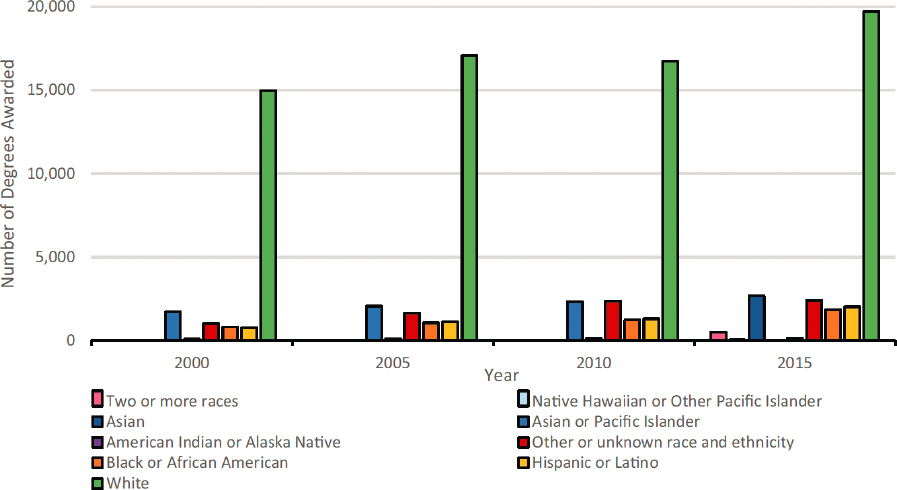
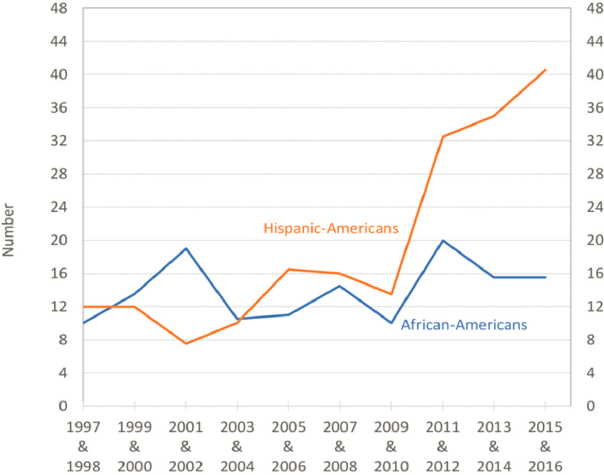
One can expect that the demographic trends in AMO sciences are not too different from physics overall. This is of course disheartening, alarming even, given the demographic shifts in the U.S. population where non-whites account for more than 40 percent of the population. On the positive side, this means that there is an enormous talent pool that physics, and correspondingly AMO sciences, could tap in the future.
While there is little doubt that there are opportunities for AMO science to grow its talent pool and increase participation from underrepresented groups, the field currently does overall appear to be slowly growing. From the data shown in Table 8.2, we see that the number of professional physicists who identify as AMO scientists grew over the past decade, but only at about the same rate as APS membership overall. Note that both had year-to-year variations that could be quite large, and almost seem to track one another. These overall increases imply robust interest in AMO sciences, and funding that seems to be keeping pace with growth.
U.S. Workforce Development and Competitiveness in a Globalizing World
Traditional AMO training focuses on physics; however, the development of quantum technology requires reaching across both academic disciplines and to industry to leverage the impact of AMO. There are existing successful portable funding models in the United States and Europe, such as the National Institutes of Health (NIH)-K99 and European Research Council (ERC) grants, that could be used as models to assist faculty appointment and early career development. For the U.S. to remain competitive in the world, more such portable grant mechanisms would prove valuable. In designing such portable funding models, it will be important to ensure that the level of research effort is compatible with teaching expectations that are standard in the U.S. physical sciences academic community. Other AMO funding agencies should develop similar models that support the transition of AMO theorists and experimentalists into faculty positions.
The AMO workforce has historically been underrepresented in theorists. With the recent cross-fertilization of fields that we have been seeing, we now have more theorists working in AMO than in the past. Few of these, however, are theorists specifically trained in AMO, as opposed to, for example, condensed-matter theorists tackling problems at the intersections with AMO. This is very different than the situation in Europe, and may contribute to the reasons that the rest of the world is rapidly overtaking us in AMO.
Despite the encouraging overall growth seen in the AMO workforce, there continues to be great demand for more of such an AMO technically trained workforce. While the data on workforce needs gathered by this committee through community input are anecdotal, this issue of the need for a technically trained workforce more
generally has been studied in great detail in recent National Academies studies. One can look to those studies for guidance in assessing the needs in AMO sciences. Fueled by the ominous and prescient report Rising Above the Gathering Storm, development of a technically skilled workforce in the United States has been the subject of a number of studies carried out by the National Academies and professional societies. Four reports are of particular relevance to this study:
- National Academies of Sciences, Engineering, and Medicine. 2018. Graduate STEM Education for the 21st Century. Washington, DC: The National Academies Press. https://doi.org/10.17226/25038. This report provided guidelines for creating a generation of students with broad technical literacy and deep specialization in their area of study, acquiring core competencies through the U.S. graduate education system.
- National Academies of Sciences, Engineering, and Medicine. 2017. Building America’s Skilled Technical Workforce. Washington, DC: The National Academies Press. https://doi.org/10.17226/23472.
- National Academies of Sciences, Engineering, and Medicine. 2016. Developing a National STEM Workforce Strategy: A Workshop Summary. Washington, DC: The National Academies Press. https://doi.org/10.17226/21900.
- National Academies of Sciences, Engineering, and Medicine. 2016. Expanding Underrepresented Minority Participation: America’s Science and Technology Talent at a Crossroads. Washington, DC: The National Academies Press. https://doi.org/10.17226/12984. This report argues the importance of a workforce that is representative of the demographics of the population, and therefore, an increasingly diverse workforce in the United States. A number of recommendations are made to increase preparation, access, motivation, support, and affordability, and for education to close achievement gaps between minority and privileged populations.
- National Academies of Sciences, Engineering, and Medicine. 2019. Minority Serving Institutions: America’s Underutilized Resource for Strengthening the STEM Workforce. Washington, DC: The National Academies Press. https://dor.org/10.17226/25257. This report notes that the United States needs to add 1 million STEM trained people to the workforce in the next decade. As the U.S. trends toward a non-white majority, there are millions of young people of color who remain strongly underrepresented in STEM. The report identifies minority serving institutions as a national resource that should be tapped to strengthen and diversify the STEM workforce.
The committee does not reproduce these studies in this report, but notes that they all urgently caution that technical education and training of the American workforce is not keeping up with the projected needs of an increasingly technical
economy. If anything, the need in AMO is even greater due to its most direct connection to industry and application.
FINDINGS AND RECOMMENDATIONS: REALIZING THE FULL POTENTIAL OF AMO SCIENCE
Several observations emerge from the studies undertaken that the committee highlights as the major findings of this chapter.
Finding: Funding trends for AMO sciences show, after correction for inflation, little to no increase over the past decade, even as the number of AMO scientists in the United States has grown.
Recommendation: It is vital that the U.S. government continue to invest as a nation in curiosity-driven atomic, molecular, and optical science that enables a diverse set of scientific ideas and approaches to be explored.
Finding: As AMO laboratory programs grow more expensive to seed, the need for seeding the research of early career investigators is increasingly important.
Recommendation: The federal government should develop seed funding and portable fellowship grant models that support the transition of atomic, molecular, and optical theorists and experimentalists into faculty positions.
Finding: The number of theoretical AMO faculty positions in the United States is perennially low (dangerously low in certain subfields of AMO). AMO theory is an important component of AMO science and presents U.S. scientists with an opportunity to contribute to a vibrant and exciting field.
Recommendation: A vibrant theory program needs to be incentivized through funding opportunities, such as a portable fellowship grant program, and through a sustained campaign of educating and hiring theoretical AMO physicists.
Finding: The participation of women in AMO science is alarmingly low, with a large gap (relative to white males) in education and career advancement opportunities and outcomes. Systemic barriers to larger participation include societal and institutional biases toward these groups—often unintentional but nonetheless impactful—that lead to already small numbers declining at each career stage. The cultural norms and practices are seen as creating unwelcoming workplaces for these groups.
Recommendation: Institutions receiving federal funding should implement stronger mechanisms to ensure a high standard of accountability in creating an inclusive workplace environment. Funding agencies may seek ways to incentivize this as well.
Finding: There is little data on URMs, but from what we do have, it is clear that the numbers are extremely low. The committee has requested data on representation of URMs in federal funding and professional society membership, but very little information is available, in keeping with the very low numbers involved. Without high-quality demographic data, the underrepresentation of certain groups continues to be relegated to guesstimation and conjecture. What we do know is that a tremendous opportunity to engage large swaths of American society in AMO science—and in all STEM fields—is being squandered. The fraction of scientists in AMO from URM groups is dramatically smaller than the fraction in the general public, making it clear that those benefiting from education and funding opportunities in AMO do not reflect the demographic shifts in the nation, and that is a lost opportunity for the entire field.
Recommendation: The entire AMO science enterprise should find a multitude of ways to tap into this growing talent pool.
CLOSING REMARKS
The excitement and tangible outcomes of AMO science, described in previous chapters, cannot be overstated. Overall U.S. participation—eminence even—in AMO science is strong, continuing to leverage investments of previous decades. However, new opportunities that require concerted and directed action to maintain U.S. eminence in the field are also highlighted. Few subfields of physics have greater impact on developing knowledge and technologies that profoundly influence society.
Even as the promise of AMO science continues to fuel research and innovation, it is apparent that education, workforce development, and career opportunities are not equitably impacting all members of society. Like so many areas of STEM, AMO science has very small representation of women and URMs. There are notable inequities and barriers for women and URMs, which are the result of cultural norms in science, unconscious and conscious biases that subtly and overtly devalue those who “don’t belong” in the dominant groups and cultures, harassing behaviors, lack of role models, and many other sociological factors. These pernicious sociological effects lead to inequitable outcomes and detract from the well-intentioned opportunities and support the AMO community tries to provide. There is much work to
be done to create a more inclusive discipline that can harness the full power of a growingly diverse American society. The AMO community will grow even stronger by addressing these issues and seizing the opportunities to draw from a growing national talent pool.
Last, it is important to note that the sustained investments in AMO science in the United States are paying off as it continues to be a dynamic exciting field that is enabling fundamental exploration while also spawning new technologies, seeding invention and innovation, and having significant intellectual, societal, and economic impact.
























